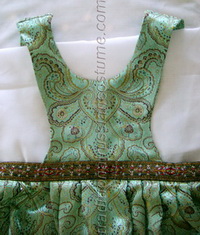
| Outfits >>> Replicas >>> Outfit of a merchant's wife. | ||

|
| |
|
Before the 18th century the traditional costume was worn by a whole society in Russia. Apparently, village people used a home-made wool and linen for clothing, but noble people could afford expensive European and Asian fabrics and decoration. The costume's silhouette depended only on the region, not on wealth. At 1700s, Peter the Great started his attempt to make Russia an European country. As a part of this, he forbade traditional clothes to aristocracy. Therefore, traditional costume become a clothing style of peasants, craftsmen, and merchants. Speaking of merchants, among them a pretty interesting clothing style appeared: it combined "the ancestors' fashion", on one hand, and European-like taste in coloring and decoration, on the other hand. Besides, the symbolism of a costume ( embroidered spells, color symbolism, etc) was forgotten in cities at that time. It was a part of a farmer's agricultural magic, so it wasn't important for city people.
At the end of 1800's, the rich merchant wife's outfit consisted of a shirt, a dress (a sarafan), a headdress, and a short coat (in contrast with village women, merchant's wives didn't wear coats all the time, but put it on only if nesessary).
A shirt (actually, an underdress) was sewn from a delicate bleached linen (which could be made by peasants), or snow-white cotton (from Eastern countries). A shirt didn't carry any protective details (no red protective trims, no embroidered spells). Armpit details were white too. A shirt's fashion became simpler: "paliki" (red shoulder's details) disappeared, and a shirt became shorter (waist-long, instead ankle-long, as in villages).
A headdress designed at that time was, actually, a "lazy mix" of
soroka-scarf and
kichka-hat.
Sometimes, instead of a brocade, people embroidered that parts of a shawl with a golden thread. The design was of "tree-and-flowers" style. Scientists think that originally the embroidery depicted fertility symbols (Tree of Life, goddesses of fertility). Village women's headdresses of the same time carry those symbols, but in cities people forgot them, and just decorated their outfits.
| ||
Sources (in Russian)
| ||


